Fake & Altered Insulators - Artificially Induced Colors
by Dwayne Anthony, NIA #3619
Reprinted from "Crown Jewels of the Wire", May 2000, page 26
Forgeries, fakes and physical alterations appear to be an escalating concern
for nearly all categories of collectibles and antiquities. The prestigious and
"electrifying" hobby of insulator collecting is, unfortunately, no
exception. Of particular concern is the recent escalation of color altered
insulators appearing primarily at flea markets and occasionally in antique shops
and antique/collectible shows. The alterations discussed here are not by
external application of paint, stains or dyes. They are a more technical
modification to the internal ingredients of the glass itself.
There are two
sources generally known for intentionally altering the integral color of glass
insulators: thermal and radiation. Both can create color changes horn very
subtle to extremely radical. Thermal alterations, as the term implies, are
achieved by use of extreme heat. Alterations performed by use of radiation
sources are much more complex and include high levels of gamma rays and electron
beams.
Why alter insulator colors?
You may be wondering, "What benefits could
possibly be gleaned from altering an insulator's color?" In many cases it
is simply underhanded greed. Example: A simple CD 145 "beehive"
insulator, embossed Postal, aqua in color, can commonly be found for sale in the
$1-3 range. The exact same insulator subjected to radiation and altered to a
stunning sapphire blue color has been known to sell for $500+ to unsuspecting
collectors! Example: A CD 121 toll insulator, embossed W.G.M. Co., royal purple
in color, can be purchased in the $25-35 range. The same insulator thermally
"cooked" to a bright burgundy color could possibly sell for $300-500!
Some collectors have been known to alter insulators for "fun" as
novelties to add to their personal collections. This is highly discouraged as an
unethical practice by the National Insulator Association. Many insulators that
were color altered as "fun novelties" in the late 1960's and early
1970's have since lost their traceable pedigree. As a result, a fair number of
these transformed insulators have been sold by, and to, unsuspecting collectors
as authentic specimens for hundreds, possibly thousands of dollars!
What colors appear as altered?
It was common practice in the manufacture of
glass insulators to use a high percentage of cullet. Cullet, a term for recycled
glass, allowed for a lower melting point, but also introduced an unknown
combination of foreign ingredients and coloring agents to a given glass batch.
In the final product these materials are often undetectable to the human eye,
but when subjected to radiation they may suddenly become an influential factor in color transformations. With this in mind and
given the countless array of ingredient variables associated with each glass
batch, it is absolutely impossible to produce a list of ALL potential colors and
shade variations.
Some exposed specimens defy all prognostication with amazing, unpattermed color changes. During one of the dozens of experimental procedures,
one CD 120 pony insulator, embossed C.E.W., was first altered from its original
color of light blue aqua to an odd olive brown. The second and third processes
produced two attractive shades of medium cornflower blue!
One very important
point to keep in mind is that color changes are not always excessive. Under
controlled situations, the slightest of color tone changes are possible. A CD
121 toll, embossed W.F.G. Co. Denver, Colo. was altered from its original color
of light lavender to dark strawberry puce, then to vivid dark purple and finally
to a medium shade of purple. Any shade between the original light lavender to
the dark puce could be attained with correct synchronization of the altering
process.
Are altered colors always recognized as fake colors?
No. This is where the
confusion really sets in. Let's examine each category separately.
Irradiated Insulators
Some irradiated insulators can exhibit similar, if not exact, color
similarities to authentic specimens. This occurs more often, but not limited to,
the purple shades. Manganese is highly excitable when exposed to radiation
sources. A very small quantity of manganese contained in an aqua insulator can
produce dense purple tones. As indicated in the previous paragraph, a light
purple insulator altered under strict controls can be "pushed" to a
very realistic medium purple, duplicating authentic specimens with extreme
accuracy. Even though such color duplications look authentic, they are, of
course, still labeled as fakes. Unfortunately, without any prior indication of
an alteration, these "chameleons" can be very difficult to identify.
Can residual radiation be detected in irradiated insulators?
For the most
part, the answer is "no". The most common sources used today to
irradiate glass insulators will leave no trace of radioactivity. Contrary to
rumors, Geiger counters can not be used as verification of irradiated glass.
There are radiation sources that can leave glass radioactive, but it is unlikely
(but not impossible!) that these sources have or are being used to irradiate
insulators. This latter form of irradiation would register on a Geiger counter.
Irradiated Insulators
|
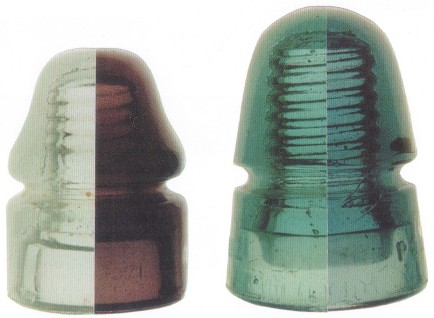
|
CD 133.1 Dec. Pat
ice aqua / dark puce |
CD 145 Postal
aqua / deep sapphire blue |
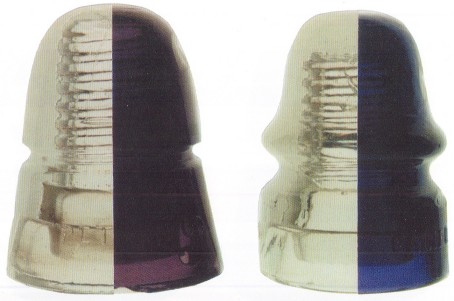 |
CD 145 H.G.Co. Petticoat
pink tint / dark purple |
CD 161 California
light smoke / royal purple |
Colors are listed left to right - left is control sample, right is altered
sample.
Irradiated Insulators
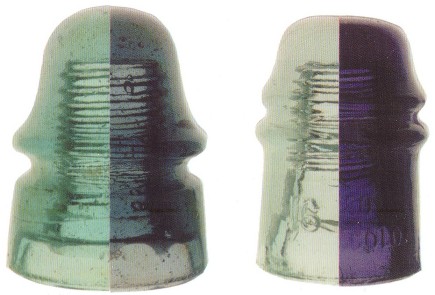 |
CD 162 Star
aqua / sapphire blue
with purple cast |
CD 121 W.F.G.Co.
ice aqua / purple |
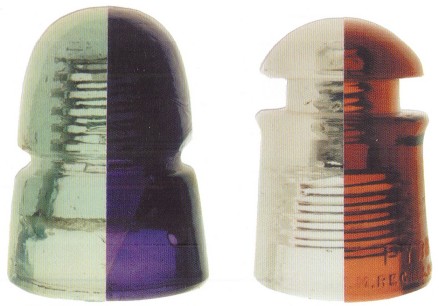 |
CD 145 "Grand Canyon"
steel blue / dark purple |
CD 128 Pyrex
clear / orange amber |
Colors are listed left to right - left is control sample, right is altered
sample.
Irradiated Insulators
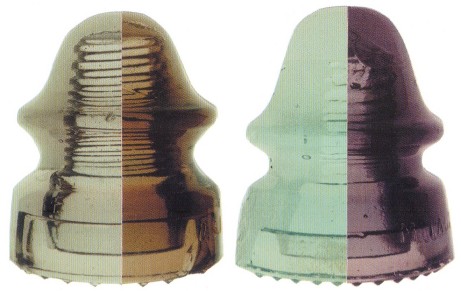 |
CD 164 Maydwell
clear / orange amber |
CD 162 McLaughlin
ice blue / purple |
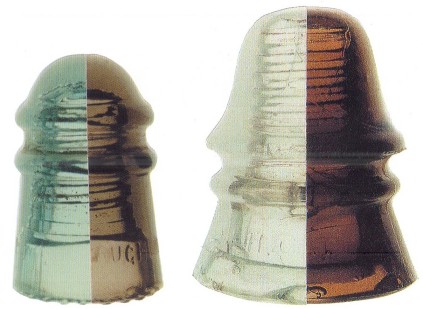 |
CD 106 McLaughlin
light blue / brown amber |
CD 151 H.G.Co. Petticoat
ice green / amber |
Colors are listed left to right - left is control sample, right is altered
sample.
Irradiated Insulators
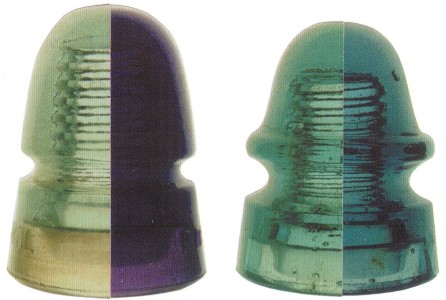 |
|
CD 145 Postal
light aqua / royal purple
|
CD 162 Star
aqua / sapphire blue |
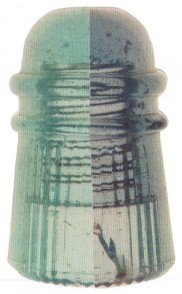
CD 121 Pleated Skirt
light aqua / sapphire blue
Colors are listed left to right - left is control sample, right is altered
sample.
Thermally Altered Insulators
Thermally altered, or "cooked" insulators present a completely
different altering process when compared to irradiation. It is important that
you fully understand the evolution of specific insulators that harbor the
potential for thermal color alterations. To immediately narrow the field of
examples, the majority of cooked insulators present in the hobby today are
embossed CALIFORNIA, or W.G.M. Co. Other varieties known, but not as prevalent,
are: AM. TEL. & TEL. Co., GOOD & POSTAL. Experimentation has proven that
several additional embossed and unembossed types are potential candidates, but
have not yet been encountered, reported or proven as such in the hobby circuit.
It is a proven fact that most, if not all, light to medium purple CALIFORNIA
insulators emerged from their factory molds in shades of off clear, smoke,
yellow or light yellow green; the darker purple/deep burgundy examples commonly
encountered were originally golden yellow. Light to medium purple W.G.M. Co.
insulators were originally clear, off clear, straw or light yellow green. These
revelations are undoubtedly raising more questions in the reader's mind, so
let's delve in a little deeper for a better understanding.
Natural color transformations.
So, how did these insulators naturally
transform into the familiar shades of purple we see today? These insulators
contain manganese. It is most probable that their manganese content was derived
from the large amount of cullet these companies commonly used for manufacturing
their insulators. Manganese, when measured properly, was used as a clarifying
agent in glass. It reacts against the coloring effects of the naturally
occurring iron in glass making formulas, thus producing clear glass as a result.
If the manganese occurred from cullet, the proportions would likely be incorrect
for clarifying, allowing the iron and/or other ingredients in the cullet to
bleed through. As a result, this "bleeding" created some of the
original insulator colors listed in the previous paragraph. When an extreme
level of manganese is present in glass, original shades of dark purple and
burgundy can result. In some cases the manganese level was accurate enough to
produce almost clear insulators.
Selenium replaced manganese as a glass
clarifying ingredient during the World War I period. However, manganese
continued to occur in some insulators for several years longer as manufacturers
repeatedly added manganese rich cullet to their glass batches.
Now that you
understand the initial effects of manganese in the production of insulators,
let's examine its secondary effects. Manganese, as mentioned previously, is a
sensitive reactor to electromagnetic radiation. Within the scope of
electromagnetic radiation there is a low level supply emitted by our sun in the
form of ultra violet light. Over a prolonged period of time, moderate to higher
levels of manganese in glass will react to the ultra violet light from the sun,
causing a "purpling" effect. Dependant upon the levels of manganese in
the glass, this purpling or solarization can produce multiple graduations in color from a pink tint to
dark purple. For example, a yellow CALIFORNIA insulator will transform to a
beautiful medium shade of rosy purple; an ice yellow green W.G.M. Co. to a light
to medium shade of purple.
Thermally Altered Insulators
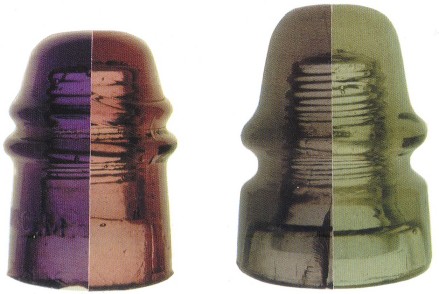 |
CD 121 W.G.M.Co.
dark purple / burgundy |
CD 161 California
smoky purple / yellow
with green tint |
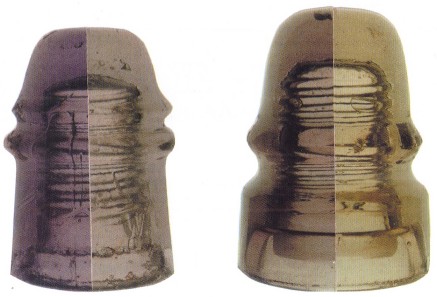 |
CD 121 W.G.M.Co.
light purple / straw with
green tint |
CD 161 California
purple / yellow |
Colors are listed left to right - left is control sample, right is altered
sample.
It is of interest to note here that multitudes of
color shade variations can occur during this ultra violet induced transformation
period. The popular "peach" color occasionally found in CALIFORNIA
insulators is actually a mid-transformation color from yellow to purple. These
insulators were evidently used in sheltered areas where very little direct
sunlight was cast upon them. Some examples display a two-tone effect that
resulted from one portion of the insulator having a stronger exposure, such as
placements near a building, partially under a roof eave or in heavily forested
areas. Insulators that were used indoors or in completely sheltered areas
remained their original color.
Thermal color reversals of sun colored insulators.
Finally, we learn what
involvement manganese has during the "cooking" process. When a sun
"purpled" insulator is heated to high temperatures, generally a step
below melting, it will, in some cases, revert back to its original color (or a
shade in close proximity). Deep purple CALIFORNIA's revert back to golden
yellow; light to medium purple W.G.M. Co.'s reverse back to varying shades of
off clear, straw, or icy yellow green. These are only a few examples. A
multitude of shade variations exist.
Thermal Color Reversals of Irradiated Insulators
It has been reported that low to moderate levels of constant heat to
irradiated insulators will reverse colors back to original. Ongoing experiments
by this writer have furnished mixed results. A clear CD 128 Pyrex insulator
subjected to intense radiation resulted in a very deep tobacco brown. This same
insulator was then subjected to 300 degrees F. for three hours in an oven and
emerged off clear. A second insulator, light aqua in color, was irradiated to an
intense dark purple. After eight hours at 500-600 degrees F. no change was
discernible. Other irradiated insulators were placed in Southern California's
hot summer sun for several weeks -- some partially reversed, some didn't. However,
ongoing extended exposures are beginning to provide positive results with most
samples.
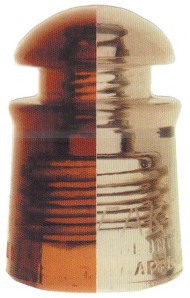
CD 128 Pyrex
orange amber / clear
with pink tint
Left is irradiated control sample, right is reversed sample.
Thermal Color Reversals of Irradiated Insulators
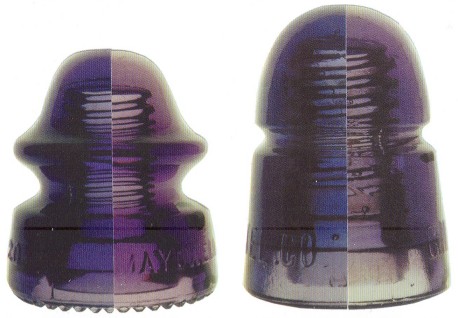 |
CD 164 Maydwell
royal purple / medium purple
(this is a partial reversal) |
CD 145 G.N.W. TEL. CO.
royal purple / medium purple |
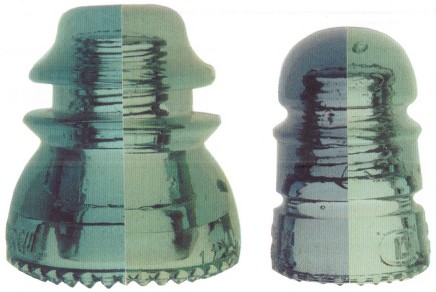 |
CD 154 Lynchburg
cornflower blue / blue aqua |
CD 112 Lynchburg
light bluish purple / aqua |
Colors are listed left to right left is irradiated control sample, right is
reversed sample.
Fake or Altered?
With all this in mind, we are now faced with the paradoxical
question: Are "cooked" insulators actually fake? A perplexing question
it is! Given the information presented here, some may argue that an insulator
cooked back to its original color should not be labeled as "fake". To
some extent this is true and here is where some separation between the two terms
"fake" & "altered" might apply. Unlike an irradiated
insulator that is transformed to a fake fantasy color, cooked insulators appear
as their previous original color. However, when it is ascertained. that an
insulator has been purposely color reversed by heat, it is no longer considered
a "factory original" and takes on the term "altered".
Regardless of which term you feel is most appropriate, all irradiated and cooked
insulators are forgeries, holding no appreciable value within our hobby.
Unfortunately, there is no easy way to identify many fake and/or altered colors.
Cooked insulators are the most difficult. Slumping glass, rack marks or
flattening on the base are possible indicators that an insulator was reheated,
but positive conclusions cannot be drawn since many authentic insulators exhibit
similar characteristics. However, if combinations of these characteristics are
apparent on a single specimen, it certainly adds more suspicion of tampering.
Conclusion:
The intention of this information is not to create paranoia, but
to make today's collector aware through education that the technology exists for
altering natural colors of genuine old glass insulators. Your best protection is
to be educated and investigate the source of any unusual color. If you happen
upon an insulator you feel falls within the suspect category, always be
suspicious and ask questions. Beware of anyone "playing dumb". Any
ethical collector or dealer will welcome questioning and should provide
sufficient answers and/or documentation. Most of all, listen to your instincts.
If it sounds too good to be true, it probably is!
The National Insulator
Association has adopted a set of guidelines for insulator collectors known as
the NIA Code of Ethics. These guidelines were established for members and
nonmembers alike to set a standard for conducting all collecting and dealing
activities honorably and honestly.
Table of resultant colors from radiation or thermal altering.
The following data was derived from extensive experimentation, as well as
reliable reports from outside sources. This is by no means a complete listing of
all possible color alterations. In some instances, shades can vary dramatically.
More listings will be added as they become available. Most, but not necessarily
all, styles (CD's) of the embossings listed are subject to the listed color
alterations. Please be aware that some of the following altered colors can occur
as authentic colors as well.
|
Embossing
|
Altered Colors
|
|
Am. Tel. & Tel.
|
Royal purple, Lt. pink, Off
clear, Sapphire Blue
|
|
Armstrong
|
Varying shades of brown
|
|
Brookfield
|
Burnt brown
aqua, Burnt olive green,
|
|
|
Burnt olive Brown, Cornflower blue,
|
|
|
Off clear, Royal
purple
|
|
California
|
Lt. yellow, Honey yellow, Lt. yellow green,
|
|
|
Golden yellow,
Peach, Golden peach,
|
|
|
Yellow/peach two-tone, Royal purple
|
|
CEW
|
Burnt olive,
Cornflower blue, Lt. cornflower blue
|
|
Diamond
|
Burgundy
|
|
Hemingray
|
Varying shades
of brown, Orange amber, Royal purple
|
|
H.G.Co.
|
Deep muddy purple, Royal purple,
Brown amber
|
|
Kerr
|
Varying shades of brown
|
|
Lynchburg
|
Brown, Smoke, Muddy dark
sage, Gray blue,
|
|
|
Cornflower blue, Lavender blue
|
|
Maydwell
|
Muddy brown, Dark muddy
purple, Purple
|
|
McLaughlin
|
Muddy brown, Muddy purple
|
|
NN "Grand Canyon"
|
Royal purple, Dark lavender purple
|
|
Patent 1871
|
Dark brown puce
|
|
NN "Pleated
Skirt"
|
Sapphire blue
|
|
Postal
|
Royal purple, Deep sapphire blue
|
|
Pyrex
|
Orange
Amber, Varying shades of brown
|
|
Radio strain
|
Dark orange amber, Dark amber, Royal
purple
|
|
Star
|
Blue, Blue lavender, Deep sapphire blue,
|
|
|
Muddy sapphire
|
|
W.E.
|
Dark
smoky sage
|
|
WFG
|
Dark muddy purple, Dark purple,
|
|
|
Royal purple, Dark puce
|
WGM
|
Burgundy, Light yellow green, Off clear,
|
|
Straw, Yellow straw
|
Whitall Tatum
|
Varying shades of brown, Royal purple
|
1678
|
Indigo blue
|
Acknowledgments: I wish to thank --
* The National Insulator Association
* The
many individuals who donated altered samples for testing.
* The following staff
at the University of California Davis: Robert G. Flocchini; Krystyna
Trzepla-Nabglo; and Mamdouh Metwally.
* San Bernardino Valley College.
* Fred
Padgett, for arranging access to U.C.D.'s services.
* Mike Guthrie, for
providing numerous test samples.
* Rick Baldwin and Mark Lauckner for technical
advice.
If you have any questions or comments regarding the preceding information,
please contact: www.nia.org (National Insulator Association)
or Dwayne Anthony,
28390 Saffron Avenue, Highland, CA 92346 or
E-mail: blobtop126@aoI.com
|
